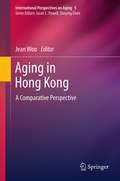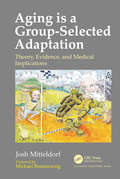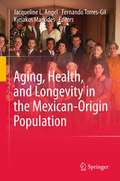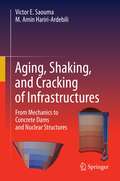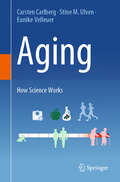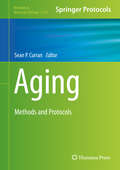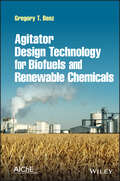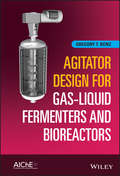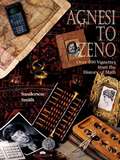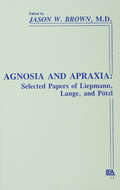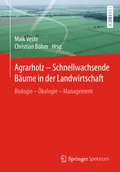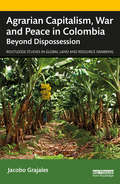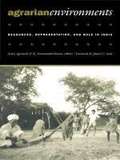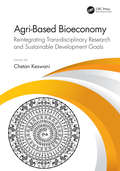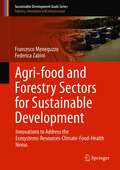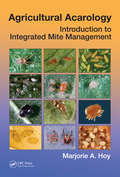- Table View
- List View
Aging in Comparative Perspective: Processes and Policies (International Perspectives on Aging #1)
by Jamie Halsall Ian Gillespie CookThis book examines the key aging processes in seven countries (United States, United Kingdom, Sweden, Japan, China, Nepal, and South Africa) and the main policies that have been, and are being, developed to deal with this rapid change in the demographic profile. It addresses the problems that are identified as well as the positive aspects of aging within each of these contrasting societies. Thus it makes a significant contribution to the major debates about growing old across the globe.
Aging in European Societies: Healthy Aging in Europe (International Perspectives on Aging #6)
by Constantinos PhellasBetween longer life expectancies and declining birth rates, Europe's elder population is growing into a sizable minority with considerable impact on nations, health systems, and economies--in other words, global implications as well as local and regional ones. Those investing in the health of older adults need a double perspective: the social and clinical complexity of aging and the larger forces shaping these experiences. Aging in European Societies examines aging trends across the continent, analyzing individual and collective variables that affect the lives of older adults, and drawing salient comparisons with other parts of the world. An interdisciplinary panel of experts provides theory, research, and empirical findings (with examples from the UK, Cyprus, Sweden, and others) in key areas such as family and social supports, physical and cognitive changes, dependence and autonomy issues, and living arrangements. The book's wide-net approach offers insights into not only aging, but aging well. And of particular importance, it details approaches to defining and measuring the elusive but crucial concept, quality of life. Included in the coverage: The potential for technology to improve elders' quality of life.Dementia and quality of life issues.Changes in functional ability with aging and over time.Family networks and supports in older age.Factors influencing inequalities in quality of life.Late-life learning in the E.U. Gerontologists, sociologists, health and cross-cultural psychologists, and public health policymakers will welcome Aging in European Societies as a springboard toward continued discussion, new directions for research, and improvements in policy and practice.
Aging in Hong Kong: A Comparative Perspective (International Perspectives on Aging #5)
by Jean WooWith the longest life expectancy for men and the second longest for women, Hong Kong typifies our planet's aging population. The daily lives of its older adults closely match the advantages and disadvantages experienced by urban elders in other developed countries. For these reasons, Hong Kong's elderly serve as a salient guide to older people's social, psychological, and healthcare needs--concerns of increasing importance as the world grows older. Aging in Hong Kong examines this emblematic population as a case study specifically in comparison with their counterparts in the West, shedding light on diverse, interrelated currents in the aging experience. Referencing numerous international studies, the book contrasts different health service arrangements and social factors and relates them to a variety of health outcomes. Its wide-ranging coverage documents health and illness trends, reviews age-friendly policy initiatives, relates health literacy to patients' active role in their own care, and discusses elders as an underserved group in the division of limited health funding and resources. This multiple focus draws readers' attention to policies that need revisiting or retooling as chapters analyze major life areas including: Living environment.Retirement and post-retirement employment issues.Financial asset management.Health literacy regarding aging issues.Elder-positive service delivery models.Ageism in the prioritization of healthcare.End-of-life issues. By assembling such a wealth of data on its subject, Aging in Hong Kong puts ongoing challenges into clear focus for gerontologists, sociologists, health and cross-cultural psychologists, public health policymakers, and others involved in improving the quality of elders' lives.
Aging is a Group-Selected Adaptation: Theory, Evidence, and Medical Implications
by Joshua MitteldorfAlthough books exist on the evolution of aging, this is the first book written from the perspective of again as an adaptive program. It offers an insight into the implications of research on aging genetics, The author proposes the Demographic Theory of Senescence, whereby aging has been affirmatively selected because it levels the death rate over time helping stabilize population dynamics and prevent extinctions.
Aging, Health, and Longevity in the Mexican-Origin Population (Social Disparities In Health And Health Care Ser.)
by Jacqueline L. Angel Fernando Torres-Gil Kyriakos MarkidesAging, Health, and Longevity in the Mexican-Origin Population creates a foundation for an interdisciplinary discussion of the trajectory of disability and long-term care for older people of Mexican-origin from a bi-national perspective. Although the literature on Latino elders in the United States is growing, few of these studies or publications offer the breadth and depth contained in this book.
Aging, Shaking, and Cracking of Infrastructures: From Mechanics to Concrete Dams and Nuclear Structures
by Victor E. Saouma M. Amin Hariri-ArdebiliThis self-contained book focuses on the safety assessment of existing structures subjected to multi-hazard scenarios through advanced numerical methods. Whereas the focus is on concrete dams and nuclear containment structures, the presented methodologies can also be applied to other large-scale ones.The authors explains how aging and shaking ultimately lead to cracking, and how these complexities are compounded by their random nature. Nonlinear (static and transient) finite element analysis is hence integrated with both earthquake engineering and probabilistic methods to ultimately derive capacity or fragility curves through a rigorous safety assessment.Expanding its focus beyond design aspects or the state of the practice (i.e., codes), this book is composed of seven sections:Fundamentals: theoretical coverage of solid mechnics, plasticity, fracture mechanics, creep, seismology, dynamic analysis, probability and statisticsDamage: that can affect concrete structures, such as cracking of concrete, AAR, chloride ingress, and rebar corrosion,Finite Element: formulation for both linear and nonlinear analysis including stress, heat and fracture mechanics,Engineering Models: for soil/fluid-structure interaction, uncertainty quantification, probablilistic and random finite element analysis, machine learning, performance based earthquake engineering, ground motion intensity measures, seismic hazard analysis, capacity/fragility functions and damage indeces,Applications to dams through potential failure mode analyses, risk-informed decision making, deterministic and probabilistic examples,Applications to nuclear structures through modeling issues, aging management programs, critical review of some analyses,Other applications and case studies: massive RC structures and bridges, detailed assessment of a nuclear containment structure evaluation for license renewal. This book should inspire students, professionals and most importantly regulators to rigorously apply the most up to date scientific methods in the safety assessment of large concrete structures.
Aging: Concepts and Controversies (7th Edition)
by Harry R. Moody Jennifer R. SasserPresenting current research in an innovative format, Aging: Concepts and Controversies encourages students to become involved and take an informed stand on the major aging issues that we face as a society. Leading author and active expert in gerontology Rick Moody provides thorough explanation of the issues in the Concepts sections and current research in the Controversy sections, demonstrating the close link between concepts and controversies in these broad areas of aging: health care, socioeconomic trends, and the life course.
Aging: Exploring a Complex Phenomenon
by Shamim I. AhmadThis book is a detailed and comprehensive synthesis of the scientific study of aging. Dozens of contributions from leading scholars review various theories of aging, and molecular, cellular, biochemical and microbial aspects of aging, among just a few of the topics included. Authoritative, wide ranging and thorough, this book will act as a source for experimental design, a comprehensive description of age related diseases, and provide information of the latest molecular theories underlying their causes. Additionally, it will target industries involved in developing anti-aging drugs, post-graduate medical students, and university libraries.
Aging: How Science Works
by Carsten Carlberg Eunike Velleuer Stine M. UlvenAging is a topic that concerns all of us, since none of us can escape it. The molecular and cellular process is built in every of the billions of cells forming our body. Some of these cells, such as immune cells and red blood cells, live only for a few days to weeks and get life-long constantly replaced by cells produced in the bone marrow. In contrast, there are cells, such as neurons and memory lymphocytes, that get as old as we get. The process of aging limits our maximal life span, which is for our humans 120 years. However, only a very few individuals reached this age. How did their life differ from others that died decades earlier? Is it just the absence of life threatening disease paired with a more healthy life style? Or is it build in in our genome or epigenome? In this book we try to give answers to these questions from the perspectives of evolution, our genome, the epigenomes of our different tissues and cell types and the functionality of our cells. We should try to understand ourselves in detail as well as in a global setting. Basic biology explains cellular mechanisms, such as growth, differentiation, and cell death, which make life as a whole possible. Every (human) organism represents a complex interplay between hundreds of different cell types forming distinctive tissues and organs with specialized tasks. These processes need to be highly orchestrated especially during development, maintenance and aging. Studying the cellular and molecular basis of aging is one of the most fascinating areas but also a great challenge. Nevertheless, research made the biggest steps in elucidating biological processes via studying malfunctions of normal mechanisms leading to different diseases, such as progeroid syndrome and cancer. We will start this book with the understanding of the human genome in relation to principles of evolution. Then we will explain the basics of gene regulation and epigenetics, i.e., the interplay of transcription factors and chromatin. Next, we will shift to cellular mechanisms of aging and discuss then the impact of nutrition and immunity on the aging process. In the following the relation of aging to so-called aging-related common diseases, such as type 2 diabetes, atherosclerosis, cancer and Alzheimer. Do we get these diseases because we are aging or are we aging because we get one of these diseases? The book will end how we can slow down the aging process so that we can age healthy. In short, healthy aging is not an option but is a must. An ancient poem says “Teach us to number our days, that we may get a heart of wisdom.” It is up to each one of us and a daily decision to live a healthy lifestyle and to be aware of the unique gift of live we all have.
Aging: Methods and Protocols (Methods in Molecular Biology #2144)
by Sean P. CurranThis volume details the impact of aging on biological system and to understand the basis of this diversity with the goal of elucidating mechanisms to optimize health. Chapters guide readers through different animal models and methodologies to examine aging at the organism, tissue, cellular, and molecular levels across the lifespan. Written in the highly successful Methods in Molecular Biology series format, chapters include introductions to their respective topics, lists of the necessary materials and reagents, step-by-step, readily reproducible laboratory protocols, and tips on troubleshooting and avoiding known pitfalls. Authoritative and cutting-edge, Aging: Methods and Protocols aims to ensure successful results in the further study of this vital field.
Agitator Design Technology for Biofuels and Renewable Chemicals
by Gregory T. BenzAgitator Design Technology for Biofuels and Renewable Chemicals Comprehensive guide to the design, installation, selection, and maintenance of agitators in the biofuels and renewable chemicals industries Agitator Design Technology for Biofuels and Renewable Chemicals is a single-source reference on all the major issues related to agitator design for biofuel, written with the intention of saving the reader time by avoiding the need to consult multiple references or sift through many pages of text to find what is needed for agitator design in specific industries. The work presents a brief introduction of basic principles and relevant theory, then goes on to cover the real-world applications of these principles, including economic evaluations of alternatives as well as supplier evaluation principles. To aid in quick and seamless reader comprehension, each chapter has the symbols used in that chapter listed and defined at the end. Overall, the work is written more as a how-to book than an academic treatise. The highly qualified author has included plenty of brevity throughout the pages with the hopes that readers go through the entire book as a single unit, rather than just skimming an occasional page or chapter as is common with other resources in similar fields. Sample topics covered in the work include: Avoiding common problems, such as using impeller diameters and speeds that would not result in even minimal solids suspension or liquid motion Choosing the right impellers for the job, understanding how power draw and pumping are calculated, and becoming familiar with biofuel/biomass agitator sizing guidelines The principles and limitations of scale-up and the most common non-Newtonian rheology applicable to biofuel applications Designing lab tests and scale-up cellulosic hydrolysis agitation, plus the uses and limitations of Computational Fluid Dynamics (CFD) As an easy-to-read and completely comprehensive resource to the subject, Agitator Design Technology for Biofuels and Renewable Chemicals is immensely valuable for professionals tasked with selecting agitation equipment or troubleshooting existing equipment, as well as those involved in planning activities and allocating resources related to project management.
Agitator Design for Gas-Liquid Fermenters and Bioreactors
by Gregory T. BenzThis book is concise reference to designing mechanically sound agitation systems that will perform the process function efficiently and economically. Currently, all the books on bioreactor and fermenter design do not focus specifically on agitation. Sections cover agitator fundamentals, impeller systems, optimum power and air flow at peak mass transfer calculations, optimizing operation for minimum energy per batch, heat transfer surfaces and calculations, shaft seal considerations, mounting method, mechanical design, and vendor evaluation.
Agnesi to Zeno: Over 100 Vignettes From the History of Math
by Sanderson SmithAgnesi to Zeno: Over 100 Vignettes from the History of Math presents a series of vignettes that highlight developments in mathematical thought and achievement as they relate to human history. For the most part, the vignettes are chronologically arranged; topics that span long periods of time are placed strategically throughout the book.
Agnosia and Apraxia: Selected Papers of Liepmann, Lange, and Potzl (Institute for Research in Behavioral Neuroscience Series)
by Ellen Perecman Jason W. Brown George Dean Emil Franzen Joachim LuwischFirst Published in 1988. The reader is invited to explore this collection of early German papers and not to analyze the work through a comparison with the present but to approach it with a relaxation of bias that extends a new hearing to old ideas. The reader may be surprised to see how little has changed in the association or callosal theory of apraxia since this review by Liepmann. Of interest is the care with which Liepmann studied his patients and the ingenious anatomical accounts.
Agrarholz – Schnellwachsende Bäume in der Landwirtschaft: Biologie - Ökologie - Management
by Maik Veste Christian BöhmDas Buch bietet eine umfassende aktuelle Zusammenfassung und Bewertung der bisherigen Forschungserfahrungen zum Thema Agrarholz und berücksichtigt sowohl Plantagenwirtschaft als auch agroforstliche Nutzungsformen. Es greift die verschiedenen Aspekte der Etablierung von Agrarholz in der Landwirtschaft aus Sicht der Pflanzenökologie und der Ökosystemforschung auf und diskutiert diese im Kontext mit der Produktivität und dem Agrarholz-Management. Zudem werden auch Aspekte der historischen Landnutzung, der Landschaftsplanung und des praktischen Flächenmanagements behandelt und wesentliche Grundlagen zur Biologie, Genetik, (Landschafts-)Ökologie, und der Nutzung von Agrarholz vermittelt. Zielgruppe sind Studierende und Lehrende der Agrar- und Forstwissenschaften, der (Landschafts)-Ökologie, der Umwelt-, Natur- und Landschaftsplanung, des Umwelt- und Ressourcenschutzes sowie Wissenschaftler, Vertreter von Fachbehörden und -verbänden, Naturschützer, Land- und Forstwirte und Anwender angrenzender Fachbereiche.
Agrarian Capitalism, War and Peace in Colombia: Beyond Dispossession (Routledge Studies in Global Land and Resource Grabbing)
by Jacobo GrajalesBased on extensive research conducted in Colombia since 2009, this book addresses the connection between land grabbing and agrarian capitalism, as well as the unfulfilled promises of peace and justice. While land remains a key resource at the core of many contemporary civil wars, the impact of high-intensity armed violence on the formation of agrarian capitalism is seldom discussed. Drawing on nearly 200 interviews, archival research, and geographical data, this book examines land grabbing and the role of violence in capital with a particular focus on one key actor in the Colombian civil war: paramilitary militias. This book demonstrates how the intricate ties between armed conflict and economy formation are obscured by the widespread belief that violence is a radical form of action, breaking with the normal course of society and disconnected from the legal economy. Under this view, dispossession is perceived as diametrically opposed to capitalist accumulation. This belief is enormously influential in precisely those bureaucratic agencies that are in charge of peacebuilding, both domestically and internationally. However, this narrow view of the relationship between armed violence and capitalism belies the close ties between plunder and lawful profit, and obscures the continuity between violent dispossession and the free market. By the same token, it legitimizes post-war inequality in the name of capitalist development. The book concludes by arguing that the promotion of radical democracy in the government of land and rural development emerges as the only reasonable path for pacifying a violent polity. The book is essential reading for students, scholars, and development aid practitioners interested in land and resource grabbing, agrarian capitalism, civil wars, and conflict resolution.
Agrarian Environments: Resources, Representations, and Rule in India
by David Gilmartin K. Sivaramakrishnan Margaret Mckean Arun Agrawal Peter VandergeestAgrarian Environments questions the dichotomies that have structured earlier analyses of environmental processes in India and offers a new way of looking at the relationship between agrarian transformation and environmental change. The contributors claim that attempts to explain environmental conflicts in terms of the local versus the global, indigenous versus outsiders, women versus men, or the community versus the market or state obscure vital dynamics of mobilization and organization that critically influence thought and policy. Editors Arun Agrawal and K. Sivaramakrishnan claim that rural social change in India cannot be understood without exploring how environmental changes articulate major aspects of agrarian transformations--technological, cultural, and political--in the last two centuries. In order to examine these issues, they have reached beyond the confines of single disciplinary allegiances or methodological loyalties to bring together anthropologists, historians, political scientists, geographers, and environmental scientists who are significantly informed by interdisciplinary research. Drawing on extensive field and archival research, the contributors demonstrate the powerful political implications of blurring the boundaries between dichotomous cultural representations, combine conceptual analyses with specific case studies, and look at why competing powers chose to emphasize particular representations of land use or social relations. By providing a more textured analysis of how categories emerge and change, this work offers the possibility of creating crucial alliances across populations that have historically been assumed to lack mutual goals. Agrarian Environments will be valuable to those in political science, Asian studies, and environmental studies.Contributors. Arun Agrawal, Mark Baker, Molly Chattopadhyaya, Vinay Gidwani, Sumit Guha, Shubhra Gururani, Cecile Jackson, David Ludden, Haripriya Rangan, Paul Robbins, Vasant Saberwal, James C. Scott, K. Sivaramakrishnan, Ajay Skaria, Jennifer Springer, Darren Zook
Agri-Based Bioeconomy: Reintegrating Trans-disciplinary Research and Sustainable Development Goals
by Chetan KeswaniThis volume concentrates on the recent scientific advancements in agricultural biotechnology and reintegrates it with socio-economic, industrial and intellectual property aspects of agricultural biotechnology and its implications for accomplishing the sustainable development goals. Adopting a unique approach, this book amalgamates science and business perspectives from an insider’s viewpoint on the agro-biotech industry, laying the foundations for students and professionals alike. This book: Is a first of its kind by addressing the recent issues emerging in agro-based economies. Will be a single-point source for recent advancements in agro-based global bioeconomy. Empowers the utilization of biotechnology to address worldwide ecological issues by supporting sustainable resolutions for global agricultural markets. Gives both foundational hypothesis and functional direction on commercialization and regulatory issues. Empowers the usage of adaptable approaches that can adjust to and uphold socially and financially valuable agro-based technologies.
Agri-Nanotechnology: Innovations for Sustainable Agriculture and Environmental Restoration
by Sukhvinder Singh Purewal Vijay Gahlaut Sandeep Kumar DashAs the global population rises and environmental challenges intensify, the need for sustainable agricultural practices has never been more critical. Agri-Nanotechnology: Innovations for Sustainable Agriculture and Environmental Restoration explores how nanoscale science is revolutionizing farming systems, enhancing crop productivity, reducing environmental footprints, and fostering ecosystem resilience. This comprehensive volume bridges the disciplines of nanoscience, agriculture, and environmental science, presenting state-of-the-art research, real-world applications, and future directions. From nanopesticides and nanofertilizers to smart delivery systems and soil remediation, the book highlights innovative solutions designed to optimize resource use while protecting natural ecosystems. Written by leading experts in the field, this book serves as an essential reference for researchers, agronomists, environmental scientists, policymakers, and students seeking to harness the power of nanotechnology for a greener, more productive planet.
Agri-food and Forestry Sectors for Sustainable Development: Innovations to Address the Ecosystems-Resources-Climate-Food-Health Nexus (Sustainable Development Goals Series)
by Francesco Meneguzzo Federica ZabiniThis book surveys state-of-the-art and prospective practices, methods and technologies in agri-food and forestry sectors to document the potential measurable improvements in areas of environmental management, food security, economic growth, social cohesion and human health at the local and global scale. With a focus on the ecosystems-resources-climate-food-health nexus as a framework towards achieving the UN Sustainable Development Goals applicable in these sectors, the book offers a portfolio of guidelines and standards that assesses the affordability, potential profitability and possible unintended consequences of interventions. The areas of intervention covered in the study include global and local forest resources management, safe wastewater reuse for irrigation, sustainable crop and plant protection (e.g. biopesticides, bioherbicides), carbon sequestration and emission reduction strategies, and safe processing methods for food and food waste (e.g. sustainable food preservatives and healthier food). The book is primarily intended for academics, professionals, and policymakers. The professional audience, including enterprises in the forestry, farming, food processing, healthcare and waste management sectors, will take advantage of the updated knowledge basis concerning the innovations in the respective practices, methods and technologies, including their feasibility, affordability and profitability, and policymakers will find useful the comprehensive review of these innovations which could be strategically promoted and deployed in the next decade, with the aim of achieving the UN Sustainable Development Goals.
Agribusiness Innovation and Contextual Evolution, Volume I: Strategic, Managerial and Marketing Advancements (Palgrave Intersections of Business and the Sciences, in association with Gnosis Mediterranean Institute for Management Science)
by Demetris Vrontis Alkis Thrassou Antonino Galati Mariantonietta FioreAgriculture is the oldest and most traditional of economic sectors, and its business has seen major evolutionary leaps over the past century. Contemporary agribusiness is being influenced and reshaped by technological advancements, geopolitical developments, globalisation, transport and logistics innovations, as well as changes in industry structure and consumer behaviour. Reflecting on these changes and providing a deep dive into this sector, this two-volume scientific works’ collection defines, refines, analyses, and prescribes the evolution of agribusiness in the present and future. Taken together, the books offer a comprehensive conceptualisation of the multifactorial macro, micro and organisational elements of agribusiness, including strategic, managerial, marketing, technological and geo-socio-political forces. Volume I explores the strategic, managerial and marketing aspects of contemporary agribusiness, and descriptively and prescriptively investigates the organisational and immediate industry practices and sectoral forces. Topics covered include circular business models, CSR communication practices, digital marketing, organisational sustainability and contemporary farming systems, to name a few..
Agribusiness Innovation and Contextual Evolution, Volume II: Technological, Societal and Channel Advancements (Palgrave Intersections of Business and the Sciences, in association with Gnosis Mediterranean Institute for Management Science)
by Demetris Vrontis Alkis Thrassou Antonino Galati Mariantonietta FioreAgriculture is the oldest and most traditional of economic sectors, and its business has seen major leaps in innovation over the past century. Contemporary agribusiness is being influenced and reshaped by technological developments, geopolitical developments, and globalisation, as well as transport and logistics innovations, changes in consumer behaviour.Reflecting on these changes and providing a deep dive into this sector, this two-volume work defines, refines, analyses, and prescribes the evolution of agribusiness in the present and future. Taken together, the books offer a comprehensive conceptualisation of the multifactorial macro, micro and organisational elements of agribusiness, including strategic, managerial, marketing, technological and geo-socio-political forces.Volume II focuses on the wider, macro-environmental forces acting upon agribusinesses, exploring the contextual evolutions that impact the sector, and the means, practices and avenues for its development.It includes topics such as digital technologies adoption, supply chain sustainability, big data analytics, women’s agricultural entrepreneurship, and simulation model decision making.
Agribusiness Management and Entrepreneurship (Third Edition)
by Michael E. Newman Walter J. WillsAgribusiness Management and Entrepreneurship is intended to fill the need for a basic textbook covering the planning, organizing, and managing of an operation; as well as provide a comprehensive source for those who wish to consider a business from the ownership point of view, specifically as it relates to the vast area of agribusiness.
Agricultural Acarology: Introduction to Integrated Mite Management
by Marjorie A. HoyWritten by a globally prominent entomologist, Agricultural Acarology: Introduction to Integrated Mite Management provides tools for developing integrated mite management programs for agriculture, including management of plant-feeding mites, mites attacking bees and livestock, and stored products. Emphasizing the biology, ecology, behavior, and diverse methods of controlling mites, this book provides an overview of the management of agriculturally important mites using all available Integrated Pest Management (IPM) tools, including biological control, cultural practices, host-plant resistance, and pesticides.Agricultural Acarology prepares agricultural managers to identify, manage, and contribute to the field of integrated mite management. An accompanying downloadable resource contains numerous color photographs of mites and the damage they cause, and PDFs of key publications.


